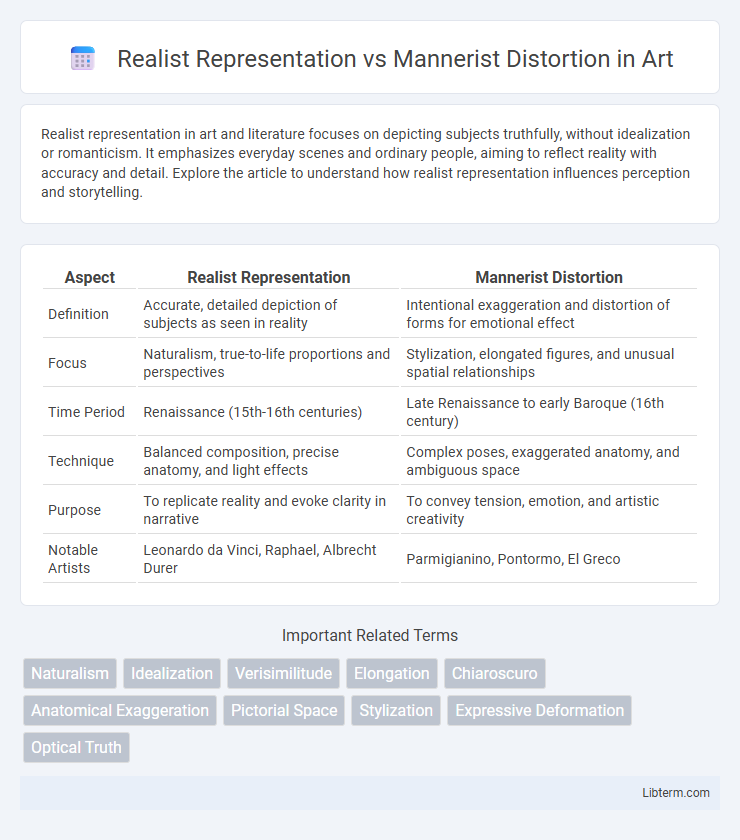Realist representation in art and literature focuses on depicting subjects truthfully, without idealization or romanticism. It emphasizes everyday scenes and ordinary people, aiming to reflect reality with accuracy and detail. Explore the article to understand how realist representation influences perception and storytelling.
Table of Comparison
| Aspect | Realist Representation | Mannerist Distortion |
|---|---|---|
| Definition | Accurate, detailed depiction of subjects as seen in reality | Intentional exaggeration and distortion of forms for emotional effect |
| Focus | Naturalism, true-to-life proportions and perspectives | Stylization, elongated figures, and unusual spatial relationships |
| Time Period | Renaissance (15th-16th centuries) | Late Renaissance to early Baroque (16th century) |
| Technique | Balanced composition, precise anatomy, and light effects | Complex poses, exaggerated anatomy, and ambiguous space |
| Purpose | To replicate reality and evoke clarity in narrative | To convey tension, emotion, and artistic creativity |
| Notable Artists | Leonardo da Vinci, Raphael, Albrecht Durer | Parmigianino, Pontormo, El Greco |
Introduction to Realist Representation and Mannerist Distortion
Realist representation emphasizes accurate, detailed depiction of subjects, aiming to mirror reality as closely as possible with precise proportions and naturalistic details. In contrast, mannerist distortion intentionally exaggerates or alters forms, proportions, and perspectives to evoke emotional responses, showcase artistic skill, or convey complex symbolism. These two approaches highlight differing artistic intentions: realism pursues fidelity to the observed world, while mannerism explores creative expression through stylized manipulation.
Historical Context: Origins and Evolution
Realist representation emerged during the Renaissance as artists sought to depict subjects with accurate proportions and lifelike detail, emphasizing naturalism and scientific observation rooted in humanism. Mannerist distortion developed in the late Renaissance as a reaction to the harmonious ideals of realism, characterized by elongated forms, exaggerated poses, and ambiguous spatial compositions reflecting socio-political uncertainty and artistic experimentation. The evolution from realism to mannerism highlights shifting cultural values and the complexity of the 16th century, marking a transition from classical balance to expressive distortion in European art history.
Key Characteristics of Realist Representation
Realist representation emphasizes accurate, detailed depictions of subjects, focusing on naturalism and everyday scenes with lifelike proportions and true-to-life colors. It captures ordinary moments and tangible textures without idealization or exaggeration, striving for objective observation and social commentary. This approach contrasts sharply with mannerist distortion, which deliberately manipulates form and perspective to convey emotional intensity or artistic expression.
Defining Features of Mannerist Distortion
Mannerist distortion is characterized by elongated proportions, exaggerated poses, and unnatural spatial arrangements that challenge the principles of realistic representation. This style emphasizes artificiality and elegance over accurate anatomical depiction, often creating a sense of tension and ambiguity. Twisted figures and ambiguous perspectives are key features that distinguish Mannerism from the balanced harmony found in Realist art.
Influential Artists: Realism vs Mannerism
Realist representation emphasizes accurate, detailed depictions of everyday scenes, championed by artists like Gustave Courbet and Jean-Francois Millet, who sought to portray life without idealization. Mannerist distortion, prevalent in the works of El Greco and Pontormo, features exaggerated proportions and complex compositions that convey emotional intensity and ambiguity. These contrasting approaches highlight the evolution from Renaissance balance to expressive experimentation in art history.
The Role of Perspective and Proportion
Realist representation emphasizes accurate perspective and proportionality to create lifelike and spatially coherent images, ensuring objects diminish in size according to their distance from the viewer. Mannerist distortion, by contrast, deliberately alters perspective and exaggerates proportions to evoke emotional tension and artistic expression over realistic depiction. The manipulation of spatial relationships in mannerism challenges the viewer's perception, contrasting with the naturalistic depth achieved through strict adherence to linear perspective in realism.
Emotional Impact and Viewer Interpretation
Realist representation emphasizes accurate, lifelike depictions that evoke empathy and clear emotional responses by mirroring real-world experiences. Mannerist distortion intentionally exaggerates proportions and forms to heighten drama, creating ambiguous or unsettling emotional impacts that invite varied viewer interpretations. This contrast influences how audiences connect with art, shifting between straightforward emotional clarity in realism and complex psychological engagement in mannerism.
Techniques and Materials Used
Realist representation employs precise techniques such as linear perspective, chiaroscuro, and naturalistic color palettes to achieve lifelike depictions, utilizing materials like oil paints on canvas or panel for fine detail and texture. Mannerist distortion, in contrast, features elongated proportions, exaggerated poses, and unusual spatial compositions, often executed with vibrant colors in mediums like tempera or oil to emphasize emotional intensity and stylistic complexity. Both movements manipulate brushwork and layering techniques but diverge in their treatment of anatomical accuracy and spatial realism, reflecting differing artistic priorities and cultural contexts.
Comparing Subject Matter and Themes
Realist representation focuses on depicting subjects with accurate detail and true-to-life appearances, often exploring everyday life, social issues, and human conditions to convey authenticity. Mannerist distortion, by contrast, exaggerates proportions, poses, and perspectives, emphasizing emotional intensity, complexity, and artificiality to create symbolic or allegorical themes. While realism grounds its themes in observable reality, mannerism uses distortion to evoke psychological tension and elaborate narratives beyond naturalistic depiction.
Legacy and Influence on Modern Art
Realist representation, with its commitment to accurate depiction and lifelike detail, laid the groundwork for movements such as Impressionism and Photorealism, influencing modern artists' pursuit of authenticity and objective observation. In contrast, Mannerist distortion, characterized by exaggerated forms and intricate compositions, inspired Expressionism and Surrealism, encouraging emotional intensity and imaginative freedom in contemporary art. Both styles collectively expanded the boundaries of artistic expression, shaping modern art's diverse approaches to realism and abstraction.
Realist Representation Infographic

 libterm.com
libterm.com